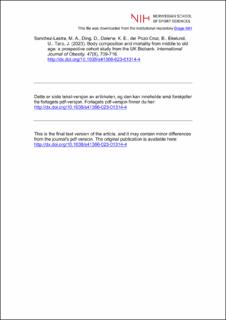| dc.contributor.author | Sanchez-Lastra, Miguel Adriano | |
| dc.contributor.author | Ding, Ding | |
| dc.contributor.author | Dalene, Knut Eirik | |
| dc.contributor.author | del Pozo Cruz, Borja | |
| dc.contributor.author | Ekelund, Ulf | |
| dc.contributor.author | Tarp, Jakob | |
| dc.date.accessioned | 2024-01-24T08:48:31Z | |
| dc.date.available | 2024-01-24T08:48:31Z | |
| dc.date.created | 2023-04-24T15:03:21Z | |
| dc.date.issued | 2023 | |
| dc.identifier.citation | International Journal of Obesity. 2023, 47(8), 709-716. | en_US |
| dc.identifier.issn | 0307-0565 | |
| dc.identifier.uri | https://hdl.handle.net/11250/3113480 | |
| dc.description | I Brage finner du siste tekst-versjon av artikkelen, og den kan inneholde ubetydelige forskjeller fra forlagets pdf-versjon. Forlagets pdf-versjon finner du på nature.com / In Brage you'll find the final text version of the nature.com | en_US |
| dc.description.abstract | Background: How the association between adiposity and the risk of death changes with age, and which is the optimal level of adiposity to reduce mortality in older ages, is still not completely understood. We aimed to ascertain the age-specific risks of mortality associated with different measures of adiposity. Methods: This was a prospective UK Biobank cohort study. Participants were categorized based on five different adiposity and body composition metrics. We explored the age-varying associations between body composition indices and all-cause mortality from 45 to 85 years of age at follow-up using hazard ratios (HR) from flexible parametric survival models with multivariable adjustment and age as timescale. Participants were followed from baseline (2006–2010) through 31 March 2020. Results: We included 369,752 participants (mean baseline age = 56.3 ± 8.1 years; range 38.9–73.7 years; 54.1% women) and 10,660 deaths during a median follow-up of 11.4 years. Associations between body mass index and mortality were similar when using the fat mass index in magnitude and shape. Compared to participants with normal weight, overweight was not associated with the risk of death regardless of age and the adiposity measure used. Participants with obesity class I showed an HR of 1.20 (95% confidence interval [CI]: 1.08, 1.33) and 1.14 (95%CI: 0.98, 1.30) at ages 60 and 80, respectively, and participants with obesity class II an HR about 1.55 across all age. More attenuated associations with higher age were found in individuals with the highest obesity using the fat mass index. Very high lean mass was associated with an increased risk of mortality in those aged 55–75 years (HR about 1.20 across all ages). Conclusion: Obesity should be prevented at any age. Attenuated associations with older age were observed only among the individuals with the highest obesity, but the risk remained higher compared to normal-weight participants. Lean mass did not reduce mortality risk at any age. | en_US |
| dc.language.iso | eng | en_US |
| dc.subject | all-cause mortality | en_US |
| dc.subject | mass index | en_US |
| dc.subject | obesity | en_US |
| dc.subject | paradox | en_US |
| dc.subject | metaanalysis | en_US |
| dc.subject | association | en_US |
| dc.subject | adiposity | en_US |
| dc.title | Body composition and mortality from middle to old age: a prospective cohort study from the UK Biobank | en_US |
| dc.title.alternative | Body composition and mortality from middle to old age: a prospective cohort study from the UK Biobank | en_US |
| dc.type | Peer reviewed | en_US |
| dc.type | Journal article | en_US |
| dc.description.version | acceptedVersion | en_US |
| dc.source.pagenumber | 709-716 | en_US |
| dc.source.volume | 47 | en_US |
| dc.source.journal | International Journal of Obesity | en_US |
| dc.source.issue | 8 | en_US |
| dc.identifier.doi | 10.1038/s41366-023-01314-4 | |
| dc.identifier.cristin | 2142949 | |
| dc.description.localcode | Institutt for idrettsmedisinske fag / Department of Sports Medicine | en_US |
| cristin.ispublished | true | |
| cristin.fulltext | original | |
| cristin.fulltext | postprint | |
| cristin.qualitycode | 2 | |
